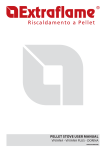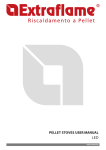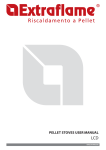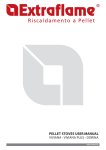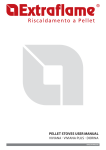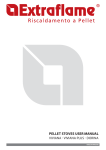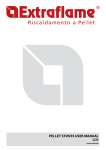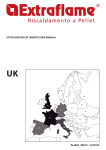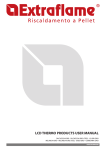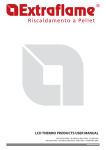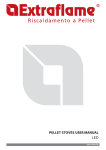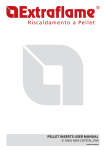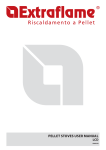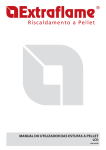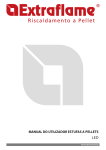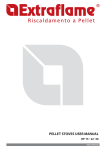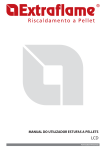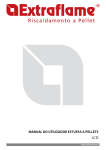Download PELLET STOVES USER MANUAL
Transcript
pellet stoves USER MANUAL
lcd
ENGLISH/INGLESE
ENGLISH
We thank you for having chosen our company; our product is a great heating solution developed from the
most advanced technology with top quality machining and modern design, aimed at making you enjoy
the fantastic sensation that the heat of a flame gives, in complete safety.
ENGLISH............................................................................................................................................................................................................. 4
Warnings......................................................................................................................................................................................................... 4
Safety............................................................................................................................................................................................................... 4
Routine Maintenance................................................................................................................................................................................. 4
Safety devices............................................................................................................................................................................................... 5
REFERENCE STANDARDS................................................................................................................................................................................. 5
General......................................................................................................................................................................................................................................................... 6
INSTALLATION................................................................................................................................................................................................... 7
Fumes exhaust system............................................................................................................................................................................... 8
General requirements....................................................................................................................................................................................................................... 8
Smoke duct................................................................................................................................................................................................................................................ 9
Chimney.......................................................................................................................................................................................................................................................11
Chimney caps..........................................................................................................................................................................................................................................11
FUMES EXHAUST SYSTEM PRODUCT REQUIREMENTS..............................................................................................................................................................12
Combustion products outlet quota...................................................................................................................................................................................12
TECHNICAL INSTALLATION DOCUMENTATION............................................................................................................................................................................13
SOUVENIR and ILENIA spacers.................................................................................................................................................................. 14
HOT AIR DUCTING........................................................................................................................................................................................... 14
Elisir..............................................................................................................................................................................................................................................................14
SOUVENIR - ILENIA...................................................................................................................................................................................................................................15
GRAZIOSA PLUS .......................................................................................................................................................................................................................................16
EMMA PLUS & TOSCA PLUS ..................................................................................................................................................................................................................16
additional thermostat for ducting motor control..............................................................................................................................................17
REARMS............................................................................................................................................................................................................ 17
Pellets and feeding.................................................................................................................................................................................. 18
Fire irons - cold handle.......................................................................................................................................................................... 18
Control panel............................................................................................................................................................................................. 19
Display icons key..................................................................................................................................................................................................................................19
General menu.............................................................................................................................................................................................. 20
Basic instructions .............................................................................................................................................................................................................................20
THE REMOTE CONTROL.................................................................................................................................................................................. 21
Delayed switch-off enabling.....................................................................................................................................................................................................21
Type and replacement of batteries........................................................................................................................................................................................21
COMMISSIONING settings.......................................................................................................................................................................... 21
Mains frequency 50/ 60Hz..............................................................................................................................................................................................................22
Adjusting time, day, month and year....................................................................................................................................................................................22
Adjusting language.........................................................................................................................................................................................................................22
Operation and logic................................................................................................................................................................................. 23
additional thermostat (optional)..................................................................................................................................................... 24
user menu..................................................................................................................................................................................................... 24
Display.........................................................................................................................................................................................................................................................24
Pellet feed adjustment..................................................................................................................................................................................................................24
V1- Air...........................................................................................................................................................................................................................................................25
STAND BY......................................................................................................................................................................................................................................................25
"keys locked"...........................................................................................................................................................................................................................................26
V2 - Air..........................................................................................................................................................................................................................................................27
reset..............................................................................................................................................................................................................................................................27
Enable chrono............................................................................................................................................................................................ 27
Chrono........................................................................................................................................................................................................... 27
Programming example....................................................................................................................................................................................................................28
Maintenance................................................................................................................................................................................................ 29
Daily cleaning to be carried out by the user.................................................................................................................................. 29
Routine maintenance .............................................................................................................................................................................. 33
Displays......................................................................................................................................................................................................... 35
ALARMS........................................................................................................................................................................................................... 36
index
ENGLISH
3
Warnings
This instructions manual is an integral part of the product: make sure that it always accompanies the appliance, even if
transferred to another owner or user, or if transferred to another place. If it is damaged or lost, request another copy from the
area technician. This product is intended for the use for which it has been expressly designed. The manufacturer is exempt from
any liability, contractual and extracontractual, for injury/damage caused to persons/animals and objects, due to installation,
adjustment and maintenance errors and improper use.
Installation must be performed by qualified staff, which assumes complete responsibility for the definitive installation
and consequent good functioning of the product installed. One must also bear in mind all laws and national, regional,
provincial and town council Standards present in the country in which the appliance has been installed, as well as the
instructions contained in this manual.
The Manufacturer cannot be held responsible for the failure to comply with such precautions.
After removing the packaging, ensure that the content is intact and complete. Otherwise, contact the dealer where the appliance
was purchased.
All electric components that make up the product must be replaced with original spare parts exclusively by an authorised aftersales centre, thus guaranteeing correct functioning.
Safety
The generator must not be used by persons (including children) with reduced physical, sensory and mental capacities or
who are unskilled persons, unless they are supervised and trained regarding use of the appliance by a person responsible for
their safety.
Children must be checked to ensure that they do not play with the appliance.
Do not touch the generator when you are barefoot or when parts of the body are wet or damp.
The safety and adjustment devices must not be modified without the authorisation or indications of the manufacturer.
Do not pull, disconnect, twist electric cables leaving the stove, even if disconnected from the electric power supply mains.
It is advised to position the power supply cable so that it does not come into contact with hot parts of the appliance.
The power supply plug must be accessible after installation.
Do not close or reduce the dimensions of the airing vents in the place of installation. The airing vents are essential for
correct combustion.
Do not leave the packaging elements within reach of children or unassisted disabled persons.
The hearth door must always be closed during normal functioning of the product.
When the appliance is functioning and hot to the touch, especially all external surfaces, attention must be paid
Check for the presence of any obstructions before switching the appliance on following a prolonged period of inactivity.
The generator has been designed to function in any climatic condition (even critical). In particularly adverse conditions
(strong wind, freezing) safety systems may intervene that switch the generator off. If this occurs, contact the technical aftersales service and always disable the safety systems.
In the event the flue catches fire, use suitable systems for suffocating the flames or request help from the fire brigade.
This appliance must not be used to burn waste
Do not use any flammable liquids for ignition
During the filling phase do not put the bag of pellets to into contact with the product
The majolicas are top quality artisan products and as such can have micro-dots, crackles and chromatic imperfections.
These features highlight their valuable nature. Due to their different dilation coefficient, they produce crackling, which
demonstrate their effective authenticity. To clean the majolicas, it is recommended to use a soft, dry cloth. If a detergent or
liquid is used, the latter could penetrate inside the crackles, highlighting them.
Routine Maintenance
Based on Decree 22 January 2008 n°37 art.2, routine maintenance means interventions aimed at reducing degradation due to
normal use, as well as dealing with accidental events entailing the need of first interventions, which however do not modify
the structure of the system upon which one is intervening or its intended use according to the requirements laid down by the
technical standards in force and by the manufacturer's use and maintenance manual.
ENGLISH
Safety devices
Key: * = present, - = not present
TERMS AND DEFINITIONS
GENERATOR
SAFETY DEVICES
Door micro switch: With the door open, the operation of
the burn pot cleaning system is blocked
-
Electronic pressure switch: in the event of inadequate
depression, it sends the machine in alarm conditions
*
F 2.5 A 250 V fuse (stoves): protects the machine from
violent current surges
*
85°C calibrated mechanical bulb with manual rearm:
intervenes by blocking fuel feed if the pellet tank t°
reaches the limit of 85°C. Rearm must be performed by
qualified staff and/or the manufacturer's technical
after-sales assistance.
*
Pellet tank temperature control probe: if the tank overheats, the machine automatically modulates to return to
normal temperature values (* in the applicable models)
*
Mechanical air pressure switch: blocks the pellet in the
event of insufficient depression (in the relevant models)
*
REFERENCE STANDARDS
The installation must be in compliance with:
UNI 10683 (2012) heat generators fed with wood and
other solid fuels: installation.
The chimneys must be in compliance with:
UNI EN 13063-1 and UNI EN 13063-2, UNI EN 1457, UNI
EN 1806 in the event of non-metallic chimneys:
EN 13384-1 (13384) chimneys. Thermal and fluid dynamic
calculation methods.
UNI EN 1443 (2005) chimneys: general requirements.
UNI EN 1457 (2012) chimneys: clay/ceramic flue liners.
UNI/TS 11278 (2008) Metal - chimneys/flue liners/flue
ducts.
UNI 7129 point 4.3.3 Fire Brigade provisions, local rules
and regulations.
National, regional, provincial and town
council regulations
One must also bear in mind all laws and national, regional,
provincial and town council Standards present in the country
in which the appliance has been installed.
Aeration: Air renewal is required both for the disposal of
the combustion products, and to prevent mixtures with a
hazardous content of non-combusted gases.
Closed hearth appliance: Appliance designed for operation
with closed combustion chamber.
Forced draught appliance: Appliance with ventilation in the
fumes circuit and combustion with fumes flow at a positive
pressure with respect to the environment.
Chimney: Structure consisting in one or several walls
containing one or several outflow airways.
The purpose of this predominantly vertical element is to expel
the combustion products at a convenient height from the
ground.
Smoke duct: Component or components that connect the
outlet of the heat generator to the chimney.
Chimney cap: Device that placed on the chimney outlet
allows the dispersion of the combustion products even in
presence of adverse weather conditions.
Condensation: Liquid products which form when the fumes
temperature is lower or equal to the water dew point.
Ducting pipe: Pipe made up of one or several predominantly
vertical elements, specifically suitable for collecting and
expelling the fumes, as well as to withstand the relative
components and any condensate over time,
suitable to be installed in a chimney, existing or new technical
compartment, even in new buildings.
Sealed installation: Installation of an appliance with sealed
operation, so that all the air required for combustion is taken
from outside.
Maintenance: Set of procedures required to ensure and
maintain safety and functionality over time and maintain the
efficiency of the system within the prescribed parameters.
Chimney system: Chimney installed using a combination
of compatible components, manufactured or specified by a
sole manufacturer whose product liability covers the entire
chimney.
Fumes exhaust system: Flue gas exhaust system,
independent from the appliance made up of a smoke duct,
chimney or individual flue and chimney cap.
Radiation area: Area immediately in front of the hearth in
which the radiant heat caused by combustion is diffused.
Reflux area: Area beyond the extrados of the roof in which
overpressure or depressions occur, which may affect the
proper discharge of the combustion products.
ENGLISH
5
FUNCTIONAL OPERATIONS DIAGRAM
State of the art installation and proper system operation include a series of activities:
1. Preliminary activities:
Verification of the suitability of the power of the heat generator based on the characteristics of the system
verification of the suitability of the installation site,
verification of the suitability of the fumes exhaust system,
verification of the suitability of the outside air inlets;
2. Installation:
implementation of ventilation and connection to the outer air inlets,
implementation and connection to the fumes exhaust system,
assembly and installation,
electric and hydraulic connections,
installation of insulation,
ignition and operation test,
installation of finishings and coverings;
3. Issue of complementary documentation;
4. Inspection and maintenance.
Other actions may be required in relation to specific requests of the competent authority.
PRELIMINARY ACTIVITIES
General
Verification of compatibility of the system, of any restrictions required by local administrative regulations, special or conventional
requirements resulting from condominium regulations, constraints, laws or administration deeds must precede any other
assembly or installation operation.
One must especially verify the suitability:
of the installation premises, of the appliances already installed in the installation premises and in the adjacent and
adjoining premises, also powered by different fuels, with particular reference to non-compliant installations.
of the fumes exhaust system
of the outside air inlets
Suitability of the fumes exhaust system
Installation must be preceded by a compatibility test between the appliance and the fumes exhaust system, by verifying:
6
the existence of documentation relating to the system;
existence and content of the chimney plaque;
suitability of the internal section of the chimney;
absence of obstructions all along the chimney;
predominantly vertical height and development of the chimney;
existence and suitability of the chimney cap;
distance of the outside wall of the chimney and of the smoke duct from
combustible materials;
chimney type and material;
absence of other chimney connections.
ENGLISH
INSTALLATION
Installation in premises with fire hazards is forbidden. Installation in residential premises (except for sealed operation appliances)
is also forbidden:
in which there are liquid fuel-operated appliances with continuous or intermittent operation, which draw the combustion
air in the room in which they are installed, or
in which there are type B gas appliances intended for room heating, with or without production of domestic hot water and
in adjacent and adjoining premises, or
in which, in any case, the depression measured during installation between the internal and external environment is
greater than 4 Pa
Installations in bathrooms, bedrooms and studio flats
Installation in bathrooms, bedrooms and studio flats is only allowed for sealed or closed hearth appliances with ducted
combustion air taken from the outside.
Installation premises requirements
The support surfaces and/or points must have a suitable load-bearing capacity to support the weight of the appliance, of the
accessories and coatings.
The adjacent, side and rear walls and the supporting surface must be made of non-combustible material. Installation near
combustible materials or those sensitive to heat is permitted as long as there is a suitable safety distance, which for pellet stoves
is equal to:
REFERENCES
A
B
C
Inflammable objects
200 mm
1500 mm
200 mm
Non-inflammable objects
100 mm
750 mm
100 mm
Flue
B
figure 1
C
Air inlet
A
Inspection
figure 2
S
S= floor protection
In any case the temperature of the adjacent combustible materials must not reach a temperature equal to or greater than the
room temperature increased by 65°C.
The minimum volume of the premises in which to install the appliance must be greater than 15 m³.
ENGLISH
7
Ventilation and aeration of the installation premises
Ventilation is deemed sufficient when the room is equipped with air inlets according to the table:
Air inlet
See figure 2
Appliance categories
Reference standard
Percentage of the
net opening section with
respect to the appliance fumes
outlet section
Pellet stoves
UNI EN 14785
-
80 cm²
Boilers
UNI EN 303-5
50%
100 cm²
Minimum net opening value of
the ventilation duct
In any case ventilation is deemed sufficient when the pressure difference between the external and internal environment is
equal to or less than 4 Pa.
In the presence of type B gas appliances with intermittent operation not intended for heating, they must have their own aeration
and/or ventilation opening. The air inlets must meet the following requirements:
they must be protected with grids, metal mesh, etc., but without reducing the net useful section;
they must be made so as to make the maintenance operations possible;
positioned so that they cannot be obstructed;
The flow of clean, uncontaminated air can also be obtained from a room adjacent to that of installation (indirect aeration and
ventilation), as long as the flow takes place freely through permanent openings communicating with the outside.
The adjacent room cannot be used as a garage, warehouse of combustible material or for any other activity with a fire hazard,
bathroom, bedroom or common room of the building.
Fumes exhaust system
General requirements
The heat generator works in a vacuum and has an output fan for fume extraction. Each appliance must be connected to a suitable
fumes exhaust system and ensure adequate dispersion of the combustion products into the atmosphere. The combustion products
must discharged above the roof. Direct discharge from the wall or towards closed spaces is forbidden, even with clear skies.
In particular, it is forbidden to use flexible and extendible metal pipes.
The chimney should only receive the exhaust of the smoke duct connected to the appliance; collective flues or conveying
exhausts from hoods above cooking appliances of any kind, or exhausts from other generators into the chimney itself or smoke
duct are not allowed.
The smoke duct and the chimney must be connected with a continuity solution, in order to prevent the chimney from resting
on the appliance.
It is forbidden to have other air supply channels and pipes for plant engineering transit inside the fumes exhaust systems,
especially if over-sized.
The components of the fumes exhaust system must be chosen in relation to the type
of appliance to be installed in compliance with:
in the event of metal chimneys, UNI/ TS 11278, with particular attention to what is stated in the specification;
in the event of non-metallic chimneys: UNI EN 13063-1 and UNI EN 13063-2, UNI EN 1457, .-UNI EN 1806; considering especially:
temperature class;
pressure class (fumes seal) at least equal to the seal required for the appliance;
moisture resistance (resistance to condensation);
class or level of corrosion and specification of the materials constituting the inner wall in contact with the fumes.
soot fire resistance class;
minimum distance from combustible materials
Where due to high efficiency a pellet stove has fumes at a temperature of less than 160°C + ambient (see technical data)
it must be resistant to moisture.
The installer of the fumes exhaust system, once the installation is complete and the relevant checks and inspections have been
made, must fix the chimney plaque supplied by the manufacturer with the product in a visible manner, near the fireplace, and
which must be completed with the following information:
8
ENGLISH
nominal diameter;
distance from combustible materials, indicated in millimetres, followed by the arrow and flame symbol;
installer data and date of installation.
Every time one must cross combustible materials, the following indications must be complied with:
a
a
a
a
a
a
b.1
b.1
b.1
b
b
b
Symbol
Description
Quota[mm]
b
Minimum distance of combustible materials from the intrados of the framework/floor/wall
500
b.1
Minimum distance of combustible materials from the extrados of the framework/floor
500
a
Minimum distance from combustible materials defined by the manufacturer
G(xxx)
The single wall pipes are indicated in white.
The insulated double wall chimney systems are indicated in grey.
One can disregard the quota only in the event of using an appropriate heat protection screen (for example: wall plate) to
protect the intrados of the framework/floor
Smoke duct
General requirements
The smoke ducts must be installed in compliance with the following general requirements:
be equipped with at least one sealed outlet for eventual fumes sampling;
they must be insulated if they cross through rooms that are not to be heated or outside the building;
they must not cross rooms in which the installation of combustion appliances is forbidden, nor in other premises
compartmentalised against fire or with a fire hazard, nor in rooms and/or areas that cannot be inspected;
they must be installed so as to allow normal thermal expansion;
they must be fitted to the opening of the chimney without protruding inwards;
the use of flexible metal pipes to connect the appliance to the chimney is not allowed;
Chimney
Chimney
Incorrect
Correct
ok
ok
ENGLISH
9
counter-slope sections are not allowed;
the smoke ducts must have, along their entire length, a diameter that is no less than that of the attachment of the appliance
exhaust pipe; any section changes are allowed only on the inlet to the chimney;
they must be installed so as to limit the formation of condensation and prevent their release from the joints;
they must be positioned at a distance no less than that indicated in the product specifications from combustible materials;
the smoke channel/duct must allow to collect the soot and to be cleaned using a swab and inspected after being
disassembled, or through inspection openings when not accessible from inside the appliance.
Additional requirements for appliances fitted with an electric fan for fumes expulsion
For the heat generator appliances equipped with electric fan for expelling fumes, the instructions below must be followed:
The horizontal sections must have a minimum upward slope of 3%
The length of the horizontal section must be minimal and, in any case, no longer than 3 metres
The number of direction changes including the one due to the use of the "T" element must not be more than 4.
Examples of correct connection to the chimney
Installation with internal - external
flue
Installation with internal flue
Protection from
rain and wind
Protection from
rain and wind
Insulated flue
Insulated flue
Condensation-proof
"T" fitting with
inspection plug
Insulated
condensationproof "T" fitting
with inspection
plug
IT IS NOT RECOMMENDED TO INSTALL A 90° BEND AS THE FIRST INITIAL PART, SINCE THE ASH WOULD BLOCK THE
PASSAGE OF THE FUMES IN A SHORT TIME, CAUSING PROBLEMS TO THE GENERATOR DRAUGHT.:
Ash deposited in
the 90° bend
Ash deposited in
the 90° bend
10
ENGLISH
Examples of correct connection to the chimney
Protection from rain
and wind
Protection from rain
and wind
Steel plate,
airtight
Max 3 mt
3 - 5%
"T" fitting with
inspection
plug
"T" fitting with
inspection plug
Insulated "T"
fitting with
inspection plug
It is mandatory to use airtight pipes.
Chimney
In addition to the general requirements, the chimneys for releasing combustion products into the atmosphere must:
operate under negative pressure (operation under positive pressure is not allowed);
have a preferably circular internal section; square or rectangular sections must have rounded corners with a radius of no
less than 20 mm (hydraulically equivalent sections may be used, as long as the ratio between the longer side and the shorter
side of the rectangle, which circumscribes the section, is in any case no greater than 1.5);
be designed for fumes be designed for fumes expulsion;
be predominantly vertical and have no narrowing along their entire length;
have no more than two direction changes with a slope angle no greater than 45°;
be fitted with, in the event of operating in damp conditions, a device for reflux drainage (condensation, rainwater);
Ducted system
A ducted system can be installed with one or more ducts, operating only with negative pressure with respect to the environment.
The flexible hose compliant with UNI EN 1856-2, with T400-G characteristics, meets the requirements.
Chimney caps
The chimney caps must meet the following requirements:
they must have a useful outlet section no less than double of that of the chimney/ducted system on which it is installed;
they must be adapted in order to prevent the penetration of rain and snow in the chimney/ducted system;
they must be built so that, in the event of winds coming from all directions and from any angle, the expulsion of combustion
products is in any case ensured;
they must be free from mechanical intake aids.
ENGLISH
11
Combustion products outlet quota
The outlet quota is determined by measuring the minimum height between the roof covering and the lower point of the fumes
expulsion section into the atmosphere; this quota must be outside the reflux area and at an adequate distance from obstacles
which hinder or make the expulsion of the combustion products difficult or from openings or accessible areas.
Reflux area
The outlet quota must be outside the reflux area calculated according to the indications below.
Near the ridge one considers the lowest between the two.
Buffer area for outlet quota
a
90°
ß
c
Clear area for outlet quota above the roof slope ( ß >10°)
Reference
Description
Clear area (mm)
c
Distance measured at 90° from the roof surface
1300
a
Height above the ridge of the roof
500
The outlet of a chimney/ducted system must not be near obstacles that may create turbulence areas and/or prevent proper
expulsion of combustion products and maintenance operations to be carried out on the roof.
Verify the presence of other chimney caps or skylights and dormers.
FUMES EXHAUST SYSTEM PRODUCT REQUIREMENTS
Temperature class
In the event of a pellet appliance, temperature classes below T200 are not allowed.
Soot fire resistance class
The fumes exhaust system interlocked with appliances supplied by solid fuels require soot fire resistance, and the specification
must be indicated by the letter G followed by the distance from combustible materials in millimeters (XX) (in compliance with
UNI EN 1443) .
In the event of pellet appliances, the fumes exhaust systems must be airtight; if double designation elements are used (G and
O, with or without seal elastomer) for connecting the appliance to the chimney, one must comply with the minimum distance
XX in millimeters, indicated for designation G; in the event of fire due to soot, one must ensure the restoration of the initial
conditions (by replacing the gaskets and damaged items and cleaning those remaining in use).
Ignition tests
Operation of the appliance must be verified with an ignition test, i.e.:
for mechanical feed appliances, one must complete the ignition test, verify proper operation for at least the next 15
minutes and adjust the switch-off;
For appliances installed in a hot water heating system (closed fireplaces, thermo-stoves), testing must also extend to the entire
hydraulic circuit.
12
ENGLISH
Coverings and finishings
The coverings and finishings must only be applied after having verified the proper operation of the appliance according to the
indicated modalities
TECHNICAL INSTALLATION DOCUMENTATION
When installation is complete, the installer must provide the owner or person acting for him, according to the legislation in
force, with the declaration of conformity, supplied with:
1) the use and maintenance manual of the appliance and of the system components (such as for example, the smoke ducts,
chimney, etc.);
2) photocopy or photograph of the chimney plaque;
3) system booklet (where applicable).
The installer must ask to be issued with a receipt stating that the documentation has been provided, and must keep it with a copy of
the technical documentation relating to the installation.
Installation performed by several parties
If the individual installation steps are carried out by different parties, each must document the work carried out for the customer
and the for the operator working on the next step.
INSPECTION AND MAINTENANCE
Frequency of operations
Maintenance of the heating system and of the appliance must be carried out on a regular basis according to the table below:
Type of appliance installed
<15kW
(15- 35) kW
Pellet operated appliance
1 year
1 year
Water operated appliances
(closed fireplaces, thermo-stoves, thermo-kitchens)
1 year
1 year
Boilers
1 year
1 year
4 t of fuel used
4 t of fuel used
Fumes exhaust system
For further details refer to the "cleaning and maintenance" chapter.
Inspection and maintenance report
At the end of the inspection and/or maintenance operations, a report must be issued and released to the owner, or person
acting for him, who must confirm its receipt in writing. The report must indicate the situations encountered, the action taken,
any components replaced or installed and any comments, recommendations and requirements.
The report must be kept with the relative documentation.
In the inspection and maintenance report one must mention:
anomalies detected that cannot be removed, which pose a risk to the safety of the user or serious damage to building;
components that have been tampered with.
If anomalies as per above were detected, the owner, or person acting for him, must be warned in writing, in the maintenance
report, to refrain from using the system until the safety conditions have been fully restored.
The inspection and maintenance report must include the main information of the technician or company who performed the
inspection and/or maintenance operations, with their contact details, date of intervention and the signature of the operator.
ENGLISH
13
SOUVENIR and ILENIA spacers
Models “SOUVENIR” and "ILENIA" feature 4 spacers at the back which delimit the minimum distance to be maintained from any
rear support.
The spacers must not be removed.
HOT AIR DUCTING
The pipe used for ducting the hot air must have an internal diameter of 80 mm, be insulated and protected against heat loss.
Installation of the relevant pipes used for ducting the hot air must be performed by
qualified staff and/or the manufacturer's technical after-sales assistance
Elisir
The “Elisir” model can be ducted at the back, to the side or at the top, for further details
relating to installation, refer to the instruction sheet included in the machine.
It is possible to use single ducting as required.
Features:
ducting outlet diameter: 80 mm
maximum recommended ducting length 6 mt
possibility to thermostat the ducting via an additional thermostat (option)
possibility to adjust the ventilation speed in percentage, ducting cannot be excluded.
ENGLISH
SOUVENIR - ILENIA
Models “SOUVENIR” and "ILENIA" can be ducted at the back (1), to the side (2) or at the top (3), for further details relating to
installation refer to the instruction sheet included in the machine.
There is the possibility to decide when to use the ducting by manually diverting the hot air flow, using a key, supplied, which
can be inserted in the relevant housing located on the upper part of the stove.
ducting into the
room
- SOUVENIR
By turning it counterclockwise (position "C") part of the air is conveyed into the ducting, by turning it clockwise
(position "A") the ducting is conveyed into the room.
It is possible to use single ducting as required.
- ILENIA
By turning it counterclockwise (position "C") the air is conveyed into the ducting, by turning it clockwise
(position "A") the air is conveyed into the room.
It is possible to use single ducting as required.
Position "A"
Features:
ducting outlet diameter: 80 mm
maximum recommended ducting length 6m
it is not possible to thermostat the ducting
possibility to adjust the fan speed in percentage.
Position "C"
3
2
ENGLISH
1
GRAZIOSA PLUS
For the GRAZIOSA PLUS model it is mandatory to duct the hot air.
There is a cover on the back, which must necessarily be removed, and connected to the ducting.
Features:
ducting outlet diameter: 80 mm
maximum recommended ducting length 6m
possibility to thermostat the ducting via an additional thermostat
possibility to adjust the fan speed in percentage.
Remove the cover!
For this product it is mandatory to duct the hot air.
It is not possible to disable the ducting motor.
Do not cover or close the ducting!
EMMA PLUS & TOSCA PLUS
The EMMA PLUS & TOSCA PLUS model offer the possibility to decide where to aim the hot air flow thanks to 2 gate valves moved
by 2 levers positioned inside the pellet tank, which must be activated via the poker supplied
(see figures below).
One can use both outlets on the back of the appliance
Features:
ducting outlet diameter: 2x80 mm
maximum recommended ducting length 2m
it is not possible to thermostat the ducting
possibility to adjust the fan speed in percentage
ENGLISH
additional thermostat for ducting motor control
For models with ducting motor there is also the possibility of thermostatting the motor itself. The connection of an external
thermostat will allow to control the ducting motor independently from stove functioning.
At this point just set the desired temperature on the thermostat; the thermostat will control the functioning of the second
motor:
with temperature to be reached (closed contact) the second
motor will follow the trend of the stove.
when the temperature has been reached (open contact), it takes the
ducting motor to 1st speed and will be
displayed by the flashing LED relating to the ducting
motor.
The ducting thermostat clamp is fitted with a jumper as standard.
See the example drawing to the side.
REARMS
The figures below illustrate the positions of the tank (85°C) rearms. Contact the qualified technician if one of the rearms should
be triggered, so as to verify the cause.
SOUVENIR
85C°
ILENIA
85C°
ENGLISH
Pellets and feeding
Pellets are made by applying high pressure to sawdust, or wood waste products (not containing paint) from sawmills, carpentry
and other activities related to processing and working with wood. Given that it does not use any glue to hold it together this
type of fuel is completely environmentally friendly. In fact the compactness of the pellets over time is guaranteed by a natural
substance found in the wood itself: wood coal. In addition to being an environmentally friendly fuel in that it pushes wood
residues to the limits pellets also have technical advantages. While wood has a calorific value of 4.4kWh/kg. (with 15% humidity
after around 18 months of seasoning) the calorific value of pellets is 5 kWh/kg. Pellet density is 650kg/m3 and the water content
is equal to 8% of its weight. For this reason they do not require seasoning in order to arrive at a sufficiently adequate degree of
heat yield.
The pellets used must comply with the characteristics described
by the following standards:
EN plus - UNI EN 16961 - 2 class a1 or a2
Ö-norm M 7135
DIN plus 51731
The manufacturer always recommended using pellets with a
diameter of 6 mm with its products.
pellet STORAGE
In order to ensure problem-free combustion pellets must be
stored in a dry place.
Open the tank lid and load the pellets using a scoop.
THE USE OF EXPIRED PELLETS OR ANY OTHER MATERIAL WILL AFFECT THE FUNCTIONALITY OF YOUR
GENERATOR AND MAY LEAD TO THE TERMINATION OF THE WARRANTY AND CESSATION OF ANY ACCOMPANYING
RESPONSIBILITY ON THE PART OF THE MANUFACTURER
Fire irons - cold handle
All models are equipped with a poker (figure 1), and some also have a "cold handle" (Figure 2). These tools facilitate door
opening/closing and cleaning operations. Generators that are equipped with a "cold handle" have a special "pocket" on the
back for storing the handle (Figure 3) when not in use.
figura 1
figura 2
figura 3
ENGLISH
Control panel
Display of various
Text messages
BUTTON
ON/OFF
TO ACCESS
THE Menu
1
2
6
4
OFF
3
5
TEMPERATURE
SETTING
ADJUSTMENT
OPERATING POWER
Display icons key
1
Indicates the receipt of the radio signal
On = during radio communication
Off = no radio communication
Fixed on = serial input disabled
Indicates the status of the additional thermostat input (GND - I3)
It indicates fumes motor operation.
Off = fumes motor disabled
On = fumes motor active
Flashing = breakdown
It indicates ducted motor operation
Off = Motor disabled
On = Motor active
Flashing = the motor is running at minimum and in modulation
mode (additional input open)
It indicates tangential fan operation (where applicable)
Off = not working
On = working
Flashing = motor at minimum
Indicates the activation of the F1 function (future set-up)
Off = function disabled
On = function active
It indicates pellet feed motor operation
Off = pellet feed motor disabled
On = pellet feed motor active
It indicates weekly programming functioning
Indicator on = weekly programming active
Indicator off = weekly programming disabled
Indicates the compensation function
Off = the function is disabled
On = the function is active
Indicates the stove modulation
On = the stove is working at the set power
Flashing = the power at which the stove is working is different to
the power set, the stove is modulating (for various reasons)
Indicates the contact of the external additional thermostat
Contact closed:
the contact of the external additional
thermostat is closed and the STBY
function is disabled
Contact open:
the contact of the external additional
thermostat is open and the STBY
function is disabled
Flashing with closed
contact:
the contact of the external additional
thermostat is closed and the STBY
function is active
Flashing with open
contact:
the contact of the external additional
thermostat is open and the STBY
function is active
ENGLISH
Indicates the presence of an alarm.
On: indicates the presence of an alarm
Off: indicates the absence of alarms
Indicates the room temperature status
Off = the T° read by the probe is above the set temperature
On = the T° read by the probe is below the set temperature
Tank probe
Off = probe ok
On = broken probe (short circuit or open)
Flashing = modulation due to tank
19
General menu
2
1
1
2
3
6
1
4
6
4
OFF
3
5
5
Go back - exit
2
3
Parameter scrolling: next (2) ; previous (3)
4
5
Modify settings data: increase (4); decrease (5)
6
Confirm - access Menu
6
Set Clock
6
*Enable Chrono
6
2
2
Chrono Setting
6
Language
6
User
6
Enable chrono
Day
PROG. 1 - 2 - 3 - 4
on/off
2
2
2
Confirm
With key 6
IT,EN,FR,DE,ES
Pellets
2
2
Stand by
2
Date
...Sunday prg1
2
on-off
2
Tangential
(Reserved to the qualified
technician)
Monday prg1...
on-off
in %
v1 air
Minutes
Stop prg1
2
2
2
2
Display
2
Technic set
Hours
Start prg1
Set prg1
07°C
2
Month
2
Year
Repeat the same steps for
The other 3 time slots
2
Keys locked
2
v2 air
Ducting
*Where present
2
Reset
Basic instructions
The following recommendations must be followed the first
times the stove is ignited:
Faint smells may be produced due to the drying of the
paints and silicones used. Do not remain in the environment
for long periods.
Do not touch the surfaces as they could still be
unstable.
Air the room well several times.
The hardening of the surfaces is terminated after
several heating processes.
This appliance must not be used to burn waste.
Before lighting the stove, the following points must be
verified:
The hydraulic system must be completed in compliance
with the guidelines of the regulations and the manual.
The tank must be full of pellets
The combustion chamber must be clean
The burn pot must be completely free and clean
Check the hermetic closure of the fire door and the ash
drawer
Check that the power supply cable is connected correctly
The bipolar switch in the rear right part must be positioned
on 1.
BURN POT DIVIDER
It is FORBIDDEN to use the appliance without the divider AND/
OR GLASS PROTECTION (see the figure to the side).
Its REMOVAL jeopardises the safety of the product and
immediately voids the warranty period.
In the event of wear or deterioration contact the assistance
service to replace the part
(The replacement is not covered by the product warranty
as it is a part subject to wear).
GLASS PROTECTION
20
ENGLISH
THE REMOTE CONTROL
All that can normally be implemented through the LCD can be adjusted using the remote control.
The table below provides a detailed description of the various functions:
1
2
4
6
3
7
5
9
8
11
14
10
13
12
INFO
15
16
1
On / Off
Pressing the key for three seconds, the stove will switch on or off
2
Power increase
Pressing the key will increase the operating power
3
Power decrease
Pressing the key will decrease the operating power
4
t° increase
The temperature setting can be increased by pressing this key
5
t° decrease
The set temperature can be decreased by pressing this key
6
Enable / disable
chrono
Pressing the key once will enable or disable the chrono
7
Delayed switch-off
enabling
The delayed switch-off can be set by pressing this key.
For example, if the stove is set to switch-off in an hour, it shall switch-off
automatically once the set time elapses, displaying the countdown every
minute for delayed automatic shutdown.
8
Menu
This key allows to access the user and technical menu (the technical
menu is reserved for assistance)
9
Increase
The temperature setting can be increased by pressing this key
10
ESC key
The key allows the user to exit any program or display and returns to the
main menu without saving the data
11
Back
The key returns to the display of the various menus
12
Confirmation key
This key confirms the adjustments made during the user menu
programming phase
13
Forward
The key allows to go forward in the various menus
14
Enable function F1
Pre-set key for future applications
15
Decrease
The key decreases the value to be set
16
Stove status
Pressing this key will display the general status of the stove
Important note: the numbers shown on the remote control are purely indicative and are not present on the remote control supplied with the product.
Type and replacement of batteries
The batteries are housed in the lower part of the remote control.
To replace them, remove the battery holder (as indicated in the figure at the back of
the remote control), remove or
insert the battery following symbols on the remote control and on the battery.
For operation, 1 CR2025, 3V lithium buffer battery is required.
If the remote control is off because it has no batteries, the stove can be controlled from the control panel on top
of it.
While replacing the battery, pay attention to the polarity by observing the symbol on the inside compartment of
the remote control.
The batteries used contain metals harmful for the environment. They must therefore be disposed of separately in
appropriate containers.
COMMISSIONING settings
Once the power cable at the back of the stove has been connected, move the switch, also located on the back, to (I).
The switch at the back of the stove powers the stove board.
The stove remains off and a first screen appears on the panel
reading OFF.
ENGLISH
21
Mains frequency 50/ 60Hz
In the event the stove is installed in a country with 60Hz frequency, the stove will display "frequenza rete errata" ("mains
frequency incorrect").
Vary the frequency as described below.
Controls procedure
Press key 6,
Select the frequency required using key 4 or 5.
Press key 6 to confirm and key 1 to return to the previous menus up to the initial status.
Adjusting time, day, month and year
Set clock allows to adjust the time and date
Set clock
Controls procedure
Day
Press key 6 and set clock will appear.
Confirm using key 6.
Use keys 4 and 5 to select the day.
Proceed by pressing key 2.
With the same procedure, use keys 4 or 5 to set and key
2 to move forward, to adjust the hours, minutes, day, month
and year
Press key 6 to confirm and key 1 to return to the
previous menus up to the initial status.
Mon, Tue, Wed, ...Sun
Hours
0...23
Minutes
00...59
Date
1...31
Month
1...12
Year
00...99
Adjusting language
It is possible to select the preferred language to display the various messages.
set language
Controls procedure
Italian
Press key 6 and set clock will appear.
Press key 2 until set Language appears.
Confirm using key 6.
Select the language using key 4 or 5.
Press key 6 to confirm and key 1 to return to the
previous menus up to the initial status.
English
Language
German
French
Spanish
No ignition
J
First ignition could even fail as the auger is empty and is not always able to load the burn pot with
the required amount of pellets on time to regularly start the flame.
If the problem occurs after only a few months working, check that routine cleaning stated in the
stove booklet, has been carried out correctly.
BURN POT BOTTOM
clean check up 1 -2
J
22
In the event the "All NO FLUSSO - all clean check up " alarm is
triggered, make sure that the bottom of the burn pot is free of
residues or scales. The holes at the bottom must be completely
free to guarantee correct combustion. one can use the function
"Pellet feed adjustment" to adjust combustion according to the
described requirements. If the alarm persists and the above listed
conditions have been checked, contact the qualified after-sales
assistance centre.
ENGLISH
Operation and logic
2
1
6
4
OFF
3
5
Ignition
Once the points listed previously have been checked, press key 1 for three seconds to ignite the stove. 15 minutes are given for
the ignition stage, after ignition and once the control temperature has been reached, the
stove interrupts the ignition phase and switches to the START-UP mode.
Starting
During the start-up stage, the stove stabilises combustion, increasing it gradually, to then start ventilation and switch to the
WORK mode.
Work
During the work stage, the stove reaches the set power and works to reach the set room temperature. See following item.
Thermostat SETTING adjustment
The room temperature setting can be set using buttons 4 and 5, from Low-07 to 40°C -Hot
Low - hot
If the temperature setting is on “Low” (set below the 7°C threshold) the stove will always function at minimum.
If the setting is on “Hot” (set above the 40°C threshold) the stove will not modulate, always functioning and only at the set power.
POWER SETTING adjustment
The power setting features 5 operating levels, via button 5, (access) 1 and 2 ( adjustment).
Power 1 = minimum level - Power 5 = maximum level.
Work with Room Probe (STANDARD)
The appliance controls the room temperature via a probe fitted on the appliance.
Once the the set temperature has been reached, it will automatically go to minimum or switch off activating the Stand by
function, reducing pellet consumption to a minimum.
By default the STBY function is always set on OFF (light
on).
For its activation and logic, follow the indications on the next page, chapter: Stand by.
Burn pot cleaning
During the work stage, the stove has an internal counter which cleans the burn pot after a set amount of time.
This stage will be shown on the display, it will bring the stove to a lower power level and will increase the fumes motor for a
programmed amount of time.
When the cleaning stage is finished, the stove will continue its work, going back to the selected power level.
Switch-off
Press key 1 for three seconds.
When the operation has been performed, the appliance automatically enters the switch- off phase, blocking the supply of
pellets.
The fumes motor and the hot air ventilation motor will remain on until the temperature of the stove has dropped below
the factory parameters.
Re-ignition
The stove can only be re-ignited if the flue gas temperature has lowered and the preset timer has been reset to zero.
DO NOT USE ANY INFLAMMABLE LIQUIDS FOR IGNITION!
DO NOT ALLOW THE BAG OF PELLETS TO COME INTO CONTACT WITH THE BOILING HOT STOVE DURING THE FILLING PHASE!
In the event of continuous no ignition, contact an authorised technician.
ENGLISH
23
additional thermostat (optional)
The appliance can control the room temperature using an additional external thermostat (optional).
After ignition (pressing key 1 or via chrono mode), the stove will work to reach the setting set on the thermostat, displaying
Work (contact closed). The standard room probe is automatically ignored.
When the room temperature has been reached (open contact) the stove will go to minimum, displaying modulate.
To install and enable it:
A mechanical or digital thermostat is required.
Remove the plug from the socket.
Referring to the figure to the side, connect the two thermostat wires
(dry contact - not 220 V!) on the relative terminals at the back of the
machine, one is red and the other one is black.
Power the stove.
Press key 5, setting the temperature on LOW.
The stove is now configured correctly.
It will work controlling the additional external thermostat.
Installation must be performed by qualified staff and/or the manufacturer's technical
after-sales assistance
J
There are two stove operating modes, which are different according to the
Stand- by function. See “Stand - by” chapter.
user menu
Display
This menu allows to adjust the brightness of the display. The possible settings range from OFF - 10 to 31.
Activating OFF, the back light of the display will go off after a preset delay.
By adjusting it between 10 and 31 the lighting intensity will be adjusted. (10 = minimum brightness 31 = maximum brightness).
The back light will go on as soon as a key is pressed or if an alarm should be triggered in the machine.
Controls procedure
Press key 6 and set clock will appear.
Press key 2 several times until user is displayed.
Press key 6.
"Display" will appear.
Use keys 4 -5 to select the brightness of the display.
Press key 6 to confirm and key 1 to return to the previous menus
up to the initial status.
2
1
6
4
OFF
3
2
5
1
6
4
OFF
3
5
Pellet feed adjustment
The following menu allows to adjust the percentage of pellet feed.
If the stove has functioning problems owing to the quantity of pellets, adjust pellet feeding directly from the control board.
The problems correlated to the amount of fuel can be divided into 2 categories:
24
ENGLISH
No fuel:
the stove can never develop a suitable flame, tending to remain very low even at high powers.
at minimum power the stove tends to almost switch-off taking the stove into “no pellets” alarm condition.
when the stove displays the “no pellets” alarm, there may be non-burned pellets inside the burn pot.
Excess fuel:
the stove develops a very high flame even at low power.
the panoramic glass is very dirty, obscuring it almost totally.
the burn pot tends to become encrusted, blocking the holes for air intake due to the excessive pellet feed, as it is only
burned partially.
The adjustment to be performed is in percentage. Therefore changing this parameter will lead to a proportional variation of all
stove feeding speeds. Feeding is from -20% to +30%.
Follow the procedure on the display to perform this adjustment:
Controls procedure
Press key 6 and set clock will appear.
Press key 2 several times until user is displayed.
Press key 6.
"Display" will appear.
Press key 2 until "pellet" appears.
Use keys 4 - increase 5 to(4) or decrease (5) the load during the
WORK stage.
Press key 6 to confirm and key 1 to return to the previous menus
up to the initial status.
V1- Air
The menu allows to adjust the speed of the front fan in percentage.
Controls procedure
Press key 6 and set clock will appear.
Press key 2 several times until user is displayed.
Press key 6.
"Display" will appear.
Press key 2 until "v1 air" appears.
Use keys 4 -5 to increase (4) or decrease (5)
Press key 6 to confirm and key 1 to return to the previous menus
up to the initial status.
1
STAND BY
stand - by with digital thermostat (standard)
Stby function set at On
If the Stby function is active (ON), when the stove reaches the set room temperature and exceeds it by 2°C, it will switch off after
a default delay time, displaying stand - by.
When the room temperature is 2°C lower than the setting and once the stove has cooled, it will start to work again at the set
power and displaying work.
ENGLISH
25
Stby function set at OFF (DEFAULT SETTING)
If the Stby function is not active (OFF), if the stove reaches the set room temperature, it will go to minimum, modulating and
displaying modulate. When the room temperature is below the setting, it will start to work again at the set power and displaying
work.
stand - by with additional thermostat
The Stby function is used if immediate stove switch-off is required when the set temperature has been reached.
By default the STBY function is always set on OFF (light
on).
Stby function set at OFF (DEFAULT SETTING)
If the Stby function is not active (OFF), if the stove reaches the set room temperature, it will go to minimum, modulating
and displaying modulate. When the room temperature is below the setting, it will start to work again at the set power and
displaying work.
Stby function set at On
When the STBY function is activated (ON), the stove, upon reaching the set room temperature and exceeding it by 2°C,
will switch off after a pre-set default delay, displaying STAND - BY.
When the room temperature is 2°C lower than the setting, the stove will start to work again at the set power
displaying WORK.
Controls procedure
Press key 6 and Set clock will appear.
Press key 2 several times to reach set user.
Confirm using key 6.
Press key 2 several times to reach Stand by.
Using key 4 or 5 select at on.
Press key 6 to confirm and key 1 to return to the previous menus
up to the initial status.
The stand-by function is active
"keys locked"
The menu allows to lock the display keys (like with mobile phones).
With the function engaged, every time a key is pressed, “keys locked” will appear.
Controls procedure
Press key 6 and set clock will appear.
Press key 2 several times until user is displayed.
Press key 6.
"Display" will appear.
Press key 2 until "keys locked" appears.
Use keys 4 -5 to select enable/disable.
Press key 6 to confirm and key 1 to return to the previous menus
up to the initial status.
J
26
Once the function is activated, use keys 1 and 5 at the same time to lock or unlock the
keyboard
ENGLISH
V2 - Air
The menu allows to adjust the speed of the ducted fan in percentage.
Controls procedure
Press key 6 and set clock will appear.
Press key 2 several times until user is displayed.
Press key 6.
Press key 2 until "v2 air" appears.
Use keys 4 -5 to increase (4) or decrease (5)
Press key 6 to confirm and key 1 to return to the previous menus
up to the initial status.
2
reset
Allows to reset all values modifiable by the user to the default values. The modified data is the following:
Controls procedure
Press key 6 and set clock will appear.
Press key 2 several times until user is displayed.
Press key 6.
Press key 2 until "reset" appears.
Press keys 4-5 to select ON and press key 6.
"done" will appear on the display to confirm
Enable chrono
It allows to enable/disable the chrono and the various time slots.
Controls procedure
Press key 6 and set clock will appear.
Press key 2 several times until enable chrono is displayed.
Press key 6, to confirm and use keys 4-5 to enable "ON" or disable "off" the chrono.
Use keys 2 -3 to select the desired time slot
Use keys 4-5 to enable "ON" or disable "off" the selected time slot.
Press key 1 several times to confirm and exit the menu.
Chrono
The chrono allows to program 4 time spans within a day to use every day of the week.
The switch-on and switch-off time can be set in every time slot, along with the days of use of the programmed time slot
and the desired room temperature (07 - 40°C).
Recommendations
The ignition and switch-off times must be within the arc of
one day, from 0 to 24 and not over several days:
Before using the chrono function, set the current day and
time. Therefore check that the points listed in the “Set clock”
sub-chapter have been followed, so that the chrono function
works. Aside from programming it, activate it as well.
Example:
Switch-on time 07:00
Switch-off time 18:00
Ignition 22:00
Switch-off 05:00
CORRECT
ENGLISH
INCORRECT
27
Programming example
Let's suppose that the weekly Programmer function is to be used and 4 time slots are to be used in the following way:
- 1st time slot: from 08:00 to 12:00 every day of the week, with room temperature at 19°C, excluding Saturday and
Sunday
- 2nd time slot: from 15:00 to 22:00 only on Saturday and Sunday, with room temperature at 21°C
Controls procedure:
Press key 6 and SET clock will appear.
Press key 2 until enable chrono
appears
Enable the chrono
Enable slot 1 and 2.
Press key 1 to exit
1st time slot switch-off
Set
Clock
Use keys 4 - 5 to enter the time “12:00”,
which corresponds to the switch-off
time of the 1st time slot.
To confirm and continue programming,
press button 6. Press button 3 to go
back to the previous parameter.
enable
chrono
* Where “ENABLE CHRONO” is not
present in the menu, enabling is done
directly in SET CHRONO.
Controls procedure:
Stop prg1
12:00
Enabling the 1st time slot days
SET CHRONO
Press key 2 and SET chrono will
appear.
To enable/ disable the days use keys 4
and 5; key 2 and 3 to scroll the various
days, the day of the week will appear,
followed by OFF
select from Monday to Friday on ON,
excluding Saturday and Sunday (OFF)
Monday..prg1
on-off
1st time slot temperature
setting
Press key 6 to confirm and continue
programming.
Start Prg1
Off
START PRG1 OFF will appear.
Press key 6 to confirm and continue
programming.
Using buttons 4 - 5 select the desired
temperature.
(Low -07 - 40°C Hot)
set prg1
19°C
To confirm and proceed press key 6.
2nd time slot switch-on*
1st time slot switch-on
Use keys 4 - 5 to enter the time “08:00”,
which corresponds to the switch-on
time of the 1st time slot.
To confirm and continue programming,
press button 6. Press button 3 to go
back to the previous parameter.
Start Prg1
08:00
At this point, the second time slot must
be programmed.
The sequence to be followed is the
same and is repeated as per the 1st
time slot switch-on.
Start prg2
Off
*2nd time slot switch-on
At this point, the second time slot must be programmed.
The sequence to be followed is the same and is repeated as per the 1st time slot switch-on.
On this occasion simply enter the time, for example start at 15:00 and Stop at 22:00 and to activate the days Saturday and
Sunday by setting them at "ON".
J
28
When the weekly Programmer is active, a box of the relative icon will appear on the
control board.
ENGLISH
Maintenance
Maintenance warnings
Inspection and maintenance operations must be carried out by specialised technicians who are aware of the directions reported
in this manual.
Before carrying out any work, make sure that:
The power cable's plug has been pulled out, as the generator might have been programmed to turn on.
All the generator parts are cold.
The ashes are completely cold.
Periodically inspect the T-shaped fitting on the smoke pipe located on the outlet of the generator by removing the hermetic
container, remove any ash and carefully place back the plug with the gasket.
Attention!
HAVE THE GENERATOR, VENTS AND SMOKE PIPE CLEANED AND CHECKED BY SPECIALISED
PERSONNEL EVERY YEAR.
Daily cleaning to be carried out by the user
Daily cleaning must be carried out by the generator’s user with the utmost care after reading the instructions related
to the procedures that need to be carried out later described in this manual.
The images are for illustration purposes.
DAILY
Scrapers:
Use the scrapers, moving upwards (for models with upper scrapers) or pulling and pushing them (for the inserts and models
with front scrapers).
Please note: scrapers are preferably used when the generator is cold; if used when the generator is hot, it is
recommended to use special gloves to protect against the heat as they can get very hot.
Open the door - Clean the glass with a damp cloth
Never spray the detergent or any other liquid used for cleaning directly on the ceramic glass
ENGLISH
29
Cleaning the burn pot and combustion chamber
1. Vacuum the residues in the burn pot
2. Take out the burn pot from the designated compartment;
3. Vacuum the ash from the burn pot's seat and the combustion chamber (3.1)
4. Use the special poker supplied to clear the holes in the burn pot.
5. Place back the burn pot and push it towards the hearth wall.
6. If there is an ash collector tray, vacuum the ash deposits
PLEASE NOTE: Use a suitable vacuum cleaner with a special container to separate the collected ash.
1.
2.
3.
3.1
3.1
4.
5.
6.
30
ENGLISH
EVERY 3/4 DAYS - WEEKLY
Ash drawer
Every 3-4 days check the ash drawer and empty it at least one/twice a week.
If there is a lower door, open/remove it.
Take out the removable ash drawer and empty it in a special container.
Vacuum the area underneath the removable ash drawer. Once you have cleaned it, place back the removable drawer and
close/place back the external door.
In some stoves the ash collector tray is located in the combustion chamber. In this case, just open the door and vacuum the
ash from the tray.
MONTHLY
Cleaning the heat exchanger:
The heat exchangers chamber must be cleaned every month as the soot deposited on the rear of the hearth wall obstructs
the regular flow of fumes, thereby affecting the performance and regular operation of the generator.
Open the door to access the combustion chamber. Take out the burn pot.
Remove or rotate, depending on the model, the upper lockbolt (A) the screws (B) or the wall lock (C) of the hearth wall (D),
take out the hearth wall (E) and clean with the poker and a suitable vacuum cleaner (F).
When cleaning has been completed, reposition the removable hearth wall (D) and secure it again with the designated screws
by turning the lockbolt in the opposite direction in relation to the one used to remove it or by placing back the hearth wall
lock.
Place back the burn pot.
ENGLISH
31
A
B
D
C
D
D
E
E
E
F
F
F
Cleaning the LOWER SUMP (IF
THERE IS ONE)
Some stove models have an
inspection sump behind the ash
drawer or underneath the combustion
chamber. In this case, just open,
remove the clamping screws and
vacuum the ash inside.
32
ENGLISH
Routine maintenance
In order to guarantee proper functioning and safety of the device, the operations indicated below must be performed every
season or more often when necessary.
DOOR, ASH DRAWER AND BURN POT GASKETS
The gaskets ensure the tightness of the generator and its consequent proper operation.
They must be checked periodically: in the event they are worn or damaged they must be replaced immediately.
These operations must be carried out by a qualified technician.
Connection to the flue
Vacuum and clean the pipe that leads to the flue yearly or whenever necessary. If there are horizontal sections, the residues
must be removed before they can obstruct flue passage.
Always follow the instructions in maximum safety conditions!
•
•
•
WITH THE GENERATOR FULLY COOLED DOWN, SWITCHED OFF AND DISCONNECTED FROM THE MAINS ELECTRICITY.
FAILURE TO CLEAN jeopardises safety!
TO ENSURE CORRECT OPERATION, THE GENERATOR MUST UNDERGO ROUTINE MAINTENANCE BY A
QUALIFIED TECHNICIAN, AT LEAST ONCE A YEAR.
D
C
A
C
A
Fumes motor (disassembly and cleaning and
fumes pipe), new silicone in required points
B
Inspection of gaskets, ash drawer and burn pot
door (replace them and apply silicone where
required)
C
Combustion chamber (total cleaning of the entire
chamber) and ignition plug tube cleaning
D
Tank (complete emptying and cleaning).
E
Room air fan disassembly and removal of dust and
any pellet debris
F
Air intake pipe inspection and of flow sensor
cleaning
B
The images are for illustration purposes.
ENGLISH
33
Routine maintenance
C
D
F
A
B
C
E
E
A
C
F
B
F
B
A
Fumes motor (disassembly and cleaning and
fumes pipe), new silicone in required points
B
Inspection of gaskets, ash drawer and burn pot
door (replace them and apply silicone where
required)
C
Combustion chamber (total cleaning of the entire
chamber) and ignition plug tube cleaning
D
Tank (complete emptying and cleaning).
E
Room air fan disassembly and removal of dust and
any pellet debris
F
Air intake pipe inspection and of flow sensor
cleaning
The images are for illustration purposes.
34
ENGLISH
Displays
Display
off
Start
Pellet feeding
Reason
Solution
Stove off
-
The start phase is in progress
-
The feeding of the pellet during the ignition phase is in progress
Ignition
The ignition phase is in progress
-
Start-up
The start phase is in progress
-
The normal work phase is in progress
-
The stove is modulating
-
Work
Modulation
The automatic burn pot cleaning is in The automatic burn pot cleaning (not in 1st power) is performed
at pre-established intervals of continued working.
BURN POT CLEANING progress.
Final cleaning
Stand by
When the stove is switched-off, final cleaning is in progress. The final cleaning phase lasts about 10
minutes.
Stove off due to temperature reached
To deactivate the STAND-BY function see the specific chapter.
and in stand-by for re-ignition.
Stove off due to an external
thermostat, waiting for re-ignition
To deactivate the STAND-BY function see the specific chapter.
Cooling stand-by
A new ignition is attempted when
the stove has just been switched-off
When the stove switches off, it is necessary to wait until complete
fumes motor switch off and then clean the burn pot.
The stove can only be re-ignited when these operations have
been performed.
Cooling stdbyblack out
The stove is cooling due to black out
On completion of the cooling phase, it will re-ignite automatically.
Room thermostat set at minimum
value.
In this way the stove only works at 1st power independently
from the power set. To escape this function just raise the room
temperature using button 4 and then key 2.
Stand by ext
Low
Hot
The stove works at set start, without ever modulating. To escape
Set room thermostat set at maximum
this function just lower the set temperature using key 4 and then
value.
key 1.
ENGLISH
35
ALARMS
DISPLAY
Fumes failure
Fumes probe
EXPLANATION
SOLUTION
Indicates the presence of an alarm.
On: indicates the presence of an alarm
Off: indicates the absence of alarms
Flashing: indicates the deactivation of the depression sensor.
The alarm can be reset by pressing key 3 for 3 seconds only if the
fumes motor has stopped and if 15 minutes have passed from
displaying the same alarm.
Fault correlated to the flue gas
exhaust motor.
The restoration operations must be carried out by an authorised
technician.
Fault correlated to the fumes probe.
The restoration operations must be carried out by an authorised
technician.
Check pellet flow (see “Pellet feed adjustment”).
Check that the machine is clean, including the flue route.
Do not rest cloths on the machine.
Other restoration operations must be carried out by an authorised
technician.
Alarm
The flue gas temperature has
Fumes overtemper- exceeded 310°C
ature
The combustion chamber or burn pot
clean check up 1 - 2 bottom are dirty.
(1 = start-up phase)
(2= work phase)
The door is not closed correctly.
The ash drawer is not closed
correctly.
The depression sensor is faulty.
The flue exhaust pipe is blocked.
Incorrect installation
Depr alarm
The mechanical depression sensor
has tripped
No
Ignition
The pellet feed-box is empty.
Pellet feed calibration inadequate.
Incorrect installation
Make sure the holes at the burn pot bottom are completely free.
Check cleanliness of the fumes pipe and the combustion chamber.
Check hermetic door closure.
Check hermetic closure of the ash drawer.
Other restoration operations must be carried out by an authorised
technician.
Contact after-sales centre
Check for the presence of pellets in the feed-box.
Adjust pellet flow (see “Pellet feed adjustment”).
Check the procedures described in the “Ignition” chapter.
Other restoration operations must be carried out by an authorised
technician.
No current during the ignition phase.
Take the stove to off conditions using key 1 and repeat the
procedure described in the "Ignition" chapter.
Other restoration operations must be carried out by an authorised
technician.
In the work phase, the t° of the flue
gases has dropped below factory
parameters
Check for the presence of pellets in the feed-box.
Regulate the pellet flow.
Other restoration operations must be carried out by an authorised
technician.
Cooling stand-by
Attempt to release the alarm with
stove still in cooling mode.
Every time the stove displays one of the alarms listed above it will
switch-off automatically.
The stove will block any release attempt during this phase,
showing the alarm itself and ATTE alternately on the display.
The alarm can be reset by pressing key 1 for 3 seconds only if the
fumes motor has stopped and if 15 minutes have passed from
displaying the same alarm.
DEPR SENSOR
DAMAGE
Component disconnected or faulty
Contact after-sales assistance
Anomalous functioning
of pellet feeding
Contact after-sales assistance
Black-Out No Ign.
No pellets
AUGER CONTROL
ALARM
36
ENGLISH
ENGLISH
ENGLISH
ENGLISH
EXTRAFLAME S.p.A. Via Dell’Artigianato, 12 36030 - MONTECCHIO PRECALCINO (VI) - ITALY
+39.0445.865911 - +39.0445.865912 - [email protected] - www.lanordica-extraflame.com
The Manufacturer reserves the right to vary the features and data shown in this booklet at any
time and without prior notice, in order to improve its products.
This manual cannot be considered as a contract for third parties.
004275888_MU_STUFE_PELLET_LCD_006








































